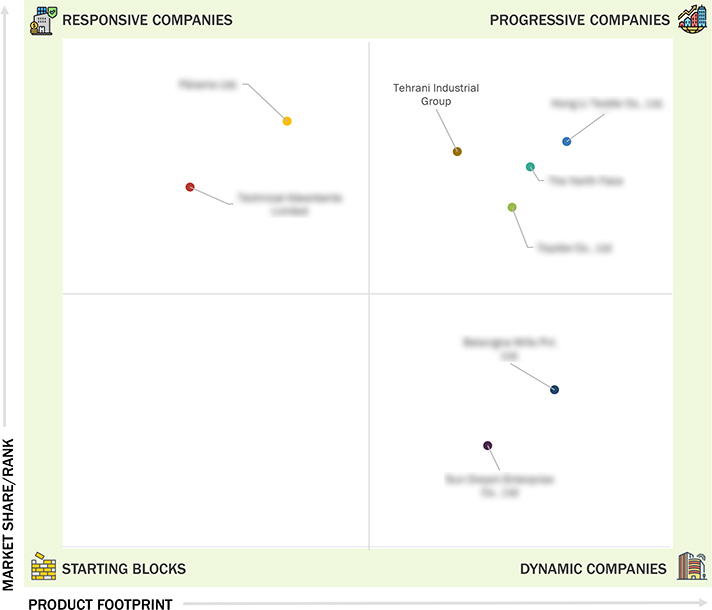Comparing 8 vendors in Cooling Fabrics Startups across 0 criteria.
Cooling fabrics use advanced spinning processes to create fibres that lower the wearer's temperature by 1–2°C. Made from synthetic and natural fibres, these fabrics pull sweat and moisture from the skin, offering dryness, breathability, and a cooling effect. The market is growing due to the demand for comfortable clothing, especially in sports and healthcare. However, their higher cost compared to regular fabrics can limit growth. The market is segmented by type, textile type, application, and region, with knitted fabrics and North America leading. Major companies like Coolcore and Polartec are expanding through acquisitions and new product developments.
Market Leadership Quadrant
1.1 Study Objectives
1.2 Market Definition
1.3 Study Scope
1.3.1 Markets Covered and Regional Scope
1.3.2 Inclusions and Exclusions
1.3.3 Years Considered
1.4 Currency Considered
1.5 Unit Considered
1.6 Limitations
1.7 Stakeholders
2.1 Introduction
2.2 Market Dynamics
2.2.1 Drivers
2.2.1.1 Increasing demand for comfortable clothing
2.2.1.2 Rapid urbanization and improved standard of living
2.2.1.3 Rising awareness about heat stress and health
2.2.2 Restraints
2.2.2.1 High cost compared to regular fabrics
2.2.2.2 Limited awareness in developing regions
2.2.3 Opportunities
2.2.3.1 Increasing use in medical and healthcare sectors
2.2.3.2 Development of sustainable and recyclable cooling fabrics
2.2.4 Challenges
2.2.4.1 Low market penetration
2.2.4.2 Competition from alternative technologies
2.3 Trends/Disruptions Impacting Customer Business
2.4 Value Chain Analysis
2.5 Ecosystem Analysis
2.6 Investment and Funding Scenario
2.7 Technology Analysis
2.7.1 Key Technologies
2.7.2 Complementary Technologies
2.7.3 Adjacent Technologies
2.8 Patent Analysis
2.9 Trade Analysis
2.10 Porter’s Five Forces Analysis
2.10.1 Threat of New Entrants
2.10.2 Threat of Substitutes
2.10.3 Bargaining Power of Suppliers
2.10.4 Bargaining Power of Buyers
2.10.5 Intensity of Competitive Rivalry
3.1 Introduction
3.2 Key Player Strategies/Right to Win
3.3 Revenue Analysis
3.4 Market Share Analysis
3.5 Company Valuation and Financial Metrics
3.6 Brand/Product Comparison
3.7 Company Evaluation Matrix: Startups/SMEs
3.7.1 Progressive Companies
3.7.2 Responsive Companies
3.7.3 Dynamic Companies
3.7.4 Starting Blocks
3.7.5 Competitive Benchmarking: Startups/SMEs
3.7.5.1 Detailed list of key startups/SMEs
3.7.5.2 Competitive benchmarking of key startups/SMEs
3.8 Competitive Scenario
3.8.1 Product Launches
3.8.2 Deals
4.1 Hong Li Textile Co., Ltd.
4.1.1 Business overview
4.1.2 Products/Solutions/Services offered
4.1.3 Recent developments
4.2 The North Face
4.2.1 Business overview
4.2.2 Products/Solutions/Services offered
4.2.3 Recent developments
4.3 Toyobo Co., Ltd
4.3.1 Business overview
4.3.2 Products/Solutions/Services offered
4.3.3 Recent developments
4.4 Tehrani Industrial Group
4.4.1 Business overview
4.4.2 Products/Solutions/Services offered
4.4.3 Recent developments
4.5 Sun Dream Enterprise Co., Ltd.
4.5.1 Business overview
4.5.2 Products/Solutions/Services offered
4.5.3 Recent developments
4.6 Balavigna Mills Pvt. Ltd.
4.6.1 Business overview
4.6.2 Products/Solutions/Services offered
4.6.3 Recent developments
4.7 Páramo Ltd.
4.7.1 Business overview
4.7.2 Products/Solutions/Services offered
4.7.3 Recent developments
4.8 Technical Absorbents Limited
4.8.1 Business overview
4.8.2 Products/Solutions/Services offered
4.8.3 Recent developments


 Innovation in Textiles
Innovation in Textiles
 Feb 2025
Feb 2025

